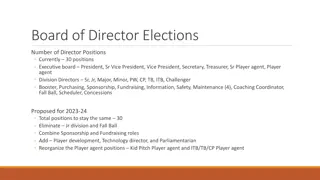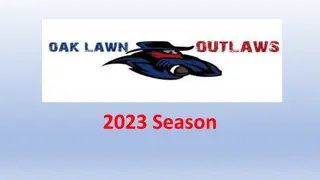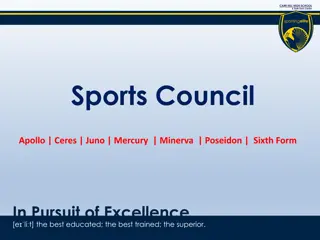Business of Sports: Ownership and League Structures
In the world of sports finance and management, understanding ownership structures and league dynamics is crucial. Explore the emergence of team sports and the evolution of major leagues in North America. Dive into the varying forms of ownership, from sole proprietorships to public ownership in sports properties.
Download Presentation

Please find below an Image/Link to download the presentation.
The content on the website is provided AS IS for your information and personal use only. It may not be sold, licensed, or shared on other websites without obtaining consent from the author.If you encounter any issues during the download, it is possible that the publisher has removed the file from their server.
You are allowed to download the files provided on this website for personal or commercial use, subject to the condition that they are used lawfully. All files are the property of their respective owners.
The content on the website is provided AS IS for your information and personal use only. It may not be sold, licensed, or shared on other websites without obtaining consent from the author.
E N D
Presentation Transcript
SPORTS FINANCE AND MANAGEMENT Real Estate, Media, and the New Business of Sport Jason A. Winfree, Mark S. Rosentraub, Brian M. Mills, and Mackenzie P. Zondlak
Chapter 2 Ownership and the Emergence of Team Sports
Sizes of Sports Business With help from favorable antitrust treatment from the U.S. Supreme Court and Congress, a league structure with defined market areas for each franchise became the most prominent and most successful model for professional leagues. The franchises created by each league would eventually settle into the largest and fastest- growing regions.
Emergence of Team Sports The growing popularity of soccer in Europe was at first subject to disdain from governments Rules and officials were seen as unnecessary to regulate a game played by gentlemen. These lessons and the value of teamwork fit well into the emerging factory life that also required adherence to rules and cooperation with others. The socializing aspect of sport to reduce labor unrest was at the heart of the interest in creating factory and community teams in North America and Europe. These teams created diversions from the dreariness of manufacturing jobs. The role of sport in maintaining and advancing social stability meant that governments were often eager to ensure that teams enjoyed a special status or were treated differently than other businesses.
Four Major Leagues in North America Major League Baseball The first professional team the Cincinnati Red Stockings began play in 1869. National Football League In 1920, a group of professional football teams met in a car dealership in Canton, Ohio to form the Professional Football Association As football became more popular in the post World War II years, a competitive league formed: the All- America Football Conference. National Basketball Association The Basketball Association formed in 1946 to challenge the nine-year old National Basketball League. But by August 1949, after competing with each other for players, the Basketball Association of America and the National Basketball League merged to form the National Basketball Association. National Hockey League The NHL was formed in 1917 with teams in Ottawa and Quebec, two in Montreal and two in Toronto. The modern era for the league begins in 1942 with six franchises in Boston, Chicago, Detroit, Montreal, New York, and Toronto.
Textbook Definitions of Ownership The three most common forms of business ownership structures are sole proprietorships, partnerships, and corporations. There does exist public ownership of some very valuable sport properties. numerous universities College sport have emerged with their own unique ownership structure which largely falls under the umbrella of a nonprofit organization
Sole Proprietorship A Changing Breed A sole proprietorship is when one individual owns a business. There are many advantages to a sole proprietorship, including low organizational costs, easy decision independence. making, secrecy, and Sole proprietors rarely have to answer to anybody. A single owner has the opportunity to utilize the team as he or she envisions and can fit the team into a long-term strategic plan for a conglomerate of firms. A sole proprietor has unlimited liability, meaning the owner s total wealth is at risk to pay off creditors.
Partnerships/Syndicates and the Single-Entity Ownership Model The initial team owners were usually individual entrepreneurs or partnerships The formation of syndicates a widely used ownership strategy today spread the risks of ownership across many investors. With several investors involved, any needs for operating cash are spread across more individuals. In addition, the extraordinary cost of acquiring a team sometimes requires a group of investors to pool their resources. One of the members of the syndicate is designated as the managing partner who essentially is the owner for all matters involving the team and its relationship with the league. The most obvious drawback to having a team owned by two or more people is that there might be disagreements among the owners. The advantage of a partnership is that any risks are shared.
Corporate Ownership: Subsidiaries and Cross-Revenue Sharing (or Not) Corporations are legal entities with all of the rights of citizenship (except for the right to vote). A board of directors oversees the work of a corporation. Shareholders those who own stock in the corporation each own a portion of the corporation (measured by the proportion of a firm s total shares that they own). Stockholders benefit by receiving profits in the form of dividends from the corporation. The benefit of a corporation over other ownership structures is that it limits owner liability.
Nonprofit Athletic departments at universities operate as nonprofit organizations Several high-profile organizations in the United States are nonprofits, such as the NFL and the United States Olympic Committee (USOC). the goal of these organizations is not to make a profit the financial decisions are not much different when compared to for-profit businesses. Nonprofit organizations still must generate revenue and maintain solid financial situations Non-profit status will certainly impact the tax status of the organization, since nonprofit organizations generally pay little or no taxes. The justification is that they are providing services for the public, whose tax payments would otherwise go to support in lieu of their nonprofit status.
College Sports Ownership- Faculty Governance in Collegiate Sport The university s athletic director (AD) oversees each team s finances, even though the college or university is ultimately responsible. The AD is the chief operating officer of each of the university s athletic teams and reports to the university s president. A university s athletic budget is typically around 5 10 percent of the university s total budget This means that any financial decisions made by the athletic department should consider the impact on the rest of the institution, which may be substantial. The importance of college sport to different stakeholders makes its governance and oversight a challenging administrative task. Students, alumni, faculty, coaches, and boosters each have their own visions of the role and importance of collegiate sport.
Financing Collegiate Sport The unique ownership and stakeholder groups of college sport do allow for different types of financing. alumni and other friends of the university and its athletic department can frequently be counted upon to make donations to support teams and their operations. This revenue stream complements the traditional sources of income that include ticket sales, media rights etc. Why would universities make the decision to spend money for intercollegiate sport? Proponents point to the benefits athletics provide for campus life and the college experience. games create an opportunity to pitch donors. there will be far more students applying for admission if a university has a great campus life and sport programs. Those who are opposed to a subsidy for university athletics focus on the problems generated when coaches seek to win and attract athletes regardless of their academic prowess. universities were originally created to provide educational opportunities, and athletic programs do not contribute to schools pursuit of the true objective of higher education. universities use the excess revenue produced by football and basketball to fund teams that attract far fewer fans
Mergers, Acquisitions, and Integration Firms can increase their size by acquiring or merging with other businesses. Often when teams merge with other businesses, it is a strategic decision related to how a team can be leveraged to benefit other assets, and vice versa to enhance franchise ownership value.
Horizontal Integration Horizontal integration implies that firms are buying their competition. Most leagues prevent individuals from owning multiple teams within the league, rendering horizontal integration impossible. The NFL does not allow individuals with a share of ownership of an NFL team in one market to own part of teams from another sport in the same market area. There are several reasons for owners to pursue horizontal integration strategies. The classic reason is to eliminate competition within and between the spectator sport and entertainment businesses Another reason for owning multiple teams is that there may be some efficiency gains. A third reason for owning multiple teams might be to minimize risk.
Vertical Integration Vertical integration means a firm owns various parts of its supply chain or other firms related to the business. Several food and beverage distribution companies own teams so their products can be sold at the venue and competitors products can be excluded. Teams can also vertically integrate with media corporations. Because the importance of media revenue is rapidly increasing, some franchises choose to allow the same company to run the team and its affiliated media outlet.
Vertical Integration The question of whether a team or league should have the same ownership as a media outlet can be a complicated one. it is sometimes more efficient to have separate owners. Sport companies might be more effective than media firms at operating teams and vice versa. In these cases, it makes more sense to have a contractual relationship. One other way teams can vertically integrate is by owning their minor league teams. This is not possible for the NFL because it does not have a minor league system, MLB and the NHL have extensive minor league systems NBA has a developmental league with 26 teams. Sometimes there are cross-marketing benefits if a major league team owns its minor league affiliate.























